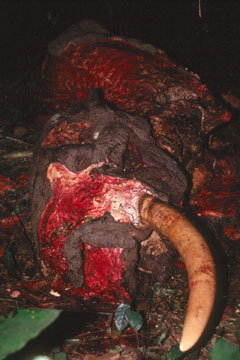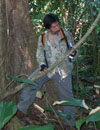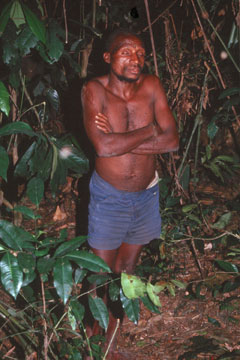Bushmeat trade “most significant” threat to Africa’s wildlife says Richard Leakey
Jeremy Hance, mongabay.com
September 25, 2008
Maverick conservationist, Richard Leakey, writes that “commercial bushmeat hunting has become the most significant immediate threat to the future of wildlife in Africa and around the world” in an article on Wildlife Direct. Founded by Leakey, Wildlife Direct is a nonprofit allowing researchers and wildlife organizations in Africa and Asia to connect directly with supporters through blogs.
A paper recently released by the Centre of International Forestry Research (CIFOR) and the Secretariat of the Convention on Biodiversity (CDB) argued that legalizing bushmeat trade is the only way to ensure species survival and provide protein needs to impoverished people. Leakey disagrees: “legalizing this multi-billion trade will not help the wildlife. It will instead exterminate what remains, species that we are working so hard to preserve.” Leakey has spent two decades working to conserve wildlife in his native Kenya.
“CIFOR argues that since up to 80 percent of the rural households in central and western Africa already depend on bushmeat for their daily protein requirements, a blanket ban on the trade would endanger both humans and wildlife ” Leakey writes. “They call for regulated but legal uptake of wildlife protein. Maybe, but just how can this be done? There are no mechanisms to regulate this even with the best legislation.”

Top: Butchered elephant carcass in the Congo rainforest (Photo by Richard Ruggiero). |
Leakey says that CIFOR and CDB’s idea of legalizing the bushmeat trade “shows remarkable naïveté and totally fails to understand the realities on the ground. A hungry population is never going to practice conservation of food, especially where it can be had free from the forest.”
Comparing legalizing the bushmeat trade to legalizing drugs, Leakey writes that there are other ways in which to provide poor communities with protein. “Why don’t people encourage the rearing of chickens, fish or cane rats to alleviate their protein deficiency? This will bring development and a better and healthier existence.”
According to Leakey a number of species that have experienced local extinctions or drastic declines due to the bushmeat trade in Africa, including elephants, chimpanzees, gorillas, pangolins, bush pigs, duikers, and monitor lizards. Numerous primate species are especially susceptible. The bushmeat trade is also a threat to many species in Asia.
Richard Leakey, son of famed anthropologist Louis Leakey, is known for his bold conservation views and his long career in politics, anthropology, and conservation in Kenya.
RELATED
Commercial bushmeat trade is devastating wildlife
(11/7/2007) Commercial killing of rainforest wildlife is putting biodiversity at risk and reducing sources of protein for rural populations, warns a new report from the Center for International Forestry Research (CIFOR) and the Secretariat of the Convention on Biological Diversity (CDB).
 |
Defaunation, like deforestation, threatens global biodiversity
(5/20/2008) Loss of wildlife is a subtle but growing threat to tropical forests, says a leading plant ecologist from Stanford University. Speaking in an interview with mongabay.com, Dr. Rodolfo Dirzo says that the disappearance of wildlife due to overexploitation, fragmentation, and habitat degradation is causing ecological changes in some of the world’s most biodiverse tropical forests. He ranks defaunation — as he terms the ongoing biological impoverishment of forests — as one of the world’s most significant global changes, on par with environmental changes like global warming, deforestation, and shifts in the nitrogen cycle.
 |
Commercial hunting may be biggest threat to tropical rainforests
(5/1/2007) Commercial hunting is decimating wildlife populations across the tropics and may be one of the gravest threats presently facing rainforests, reports a series of studies published in the May issue of the journal Biotropica. The research reveals that large-scale loss of wildlife is already affecting forest health and regeneration.














